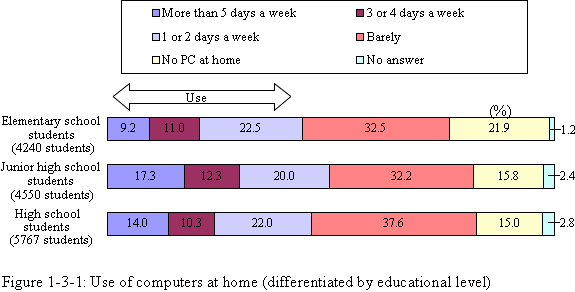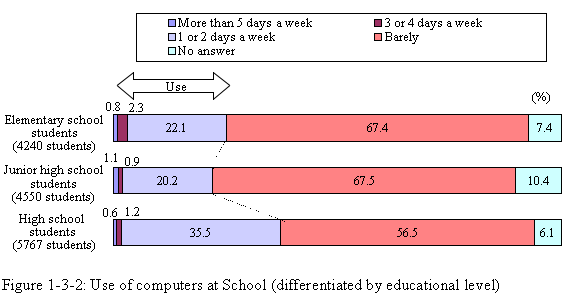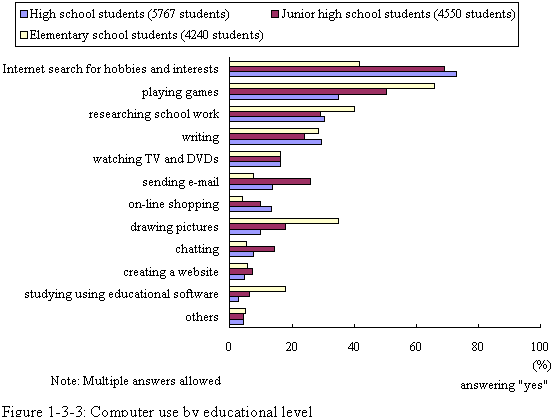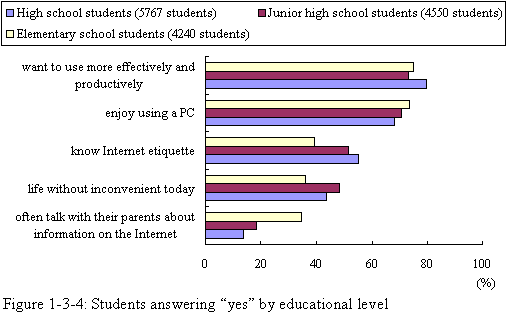Basic Survey on Daily Life of Children in Japan I
More than 40% of children from elementary to high school students use computers at least once or twice a week. Junior high school students use computers more often at home than at school however, high school students tend to use them more at school.
Computer Use at Home and School
Nowadays computer have become a vital tool in everyday life due to the rapid and steady development and spread of information technology (IT). It is not fully known, however, how children respond to and use this new type of media. A survey was therefore conducted to reveal how many times a week and where children use computers. Figure 1-3-1 shows the results of the survey by educational level (elementary, junior high, and high school).
Figure 1-3-2 also shows how often children use computers at school. A majority of children in each of the three groups, 67.4%, 67.5%, 56.5%, respectively, replied that they rarely use a computer at school, much lower percentages compared with PC use at home. Among students who use PCs at school, an overwhelming majority of them reported that they use a PC just once or twice a week. High school students are most likely to use a PC at school. Information processing classes could give them more opportunities to increase computer use at school.
Do factors such like where they live, academic performance (of elementary and junior high school students) and high school level influence the percentage of students who use computers at least once a week? The following is an analysis of PC usage according to educational level. Table 1-3-1 shows the percentage of PC users among students according to size of the region: large city, medium-sized city, and rural district. Regarding PC use at home, elementary school students living in large and medium-sized cities and high school students in large cities are more likely to use a PC at home than those in rural districts. There seems to be no regional difference among junior high school students. Regarding usage at school, elementary school students who live in medium-sized cities have the highest percentage (34.1%) and both junior high school and high students in rural restricts mark the highest percentage, 29%, 49.8%, respectively. As for frequency of PC usage both at school and home, regional differences are reported, especially between large and medium-sized cities, and rural districts.
Table 1-3-1: Use of computers at home and in school (differentiated by educational level, by region)
Table 1-3-2 shows difference in PC usage by academic performance and high school level. Elementary and junior high school students are divided into three groups by academic performance, and high school students by school level. Regarding PC usage at home, top students at elementary schools, top and average students at junior high schools and students at top ranked high schools are more likely to use a PC at home. The higher the academic level, the more frequently students use a PC at home. Elementary school students and junior high school students show no difference in PC usage at school according to academic performance. However, high schools that send many students to college and those that have creative and personally enriching classes tend to encourage students to use computers at school. Students at these schools are more likely to use computers at school. A correlation was found between academic performance and the frequency of PC use at home. However, no connection between academic performance and the frequency of PC usage at school was found for high school students.
Table 1-3-2: Use of computers at home and in school (differentiated by educational level, by academic performance and high school level)
-Students are divided into 3 groups: upper, middle and lower level of academic performance for elementary and junior high school students. Elementary school students' academic performance is summed up the points of self-evaluation for Japanese, arithmetic, science, social studies.
-Junior high school students' academic performance is summed up the points of self-evaluation for Japanese, mathematic, science, social studies and English.
-High school students are divided into 3 groups: Upper, Middle and lower school level.
"Upper" indicates high schools which send many students to college.
"Middle" indicates high schools which send about half students to college.
"Lower" indicates high schools which provide classes focusing students' creativity and personal quality.
2. Purpose of Computer Use
The purpose of computer use differs by educational level. For example, elementary school students mainly use computers to play games while junior high and high school students, on the other hand, use them for Internet searches related to hobbies and interests. Regarding the usage of personal computers, most children at each educational level answered that they enjoy using a PC and hope to learn more.
Nature of Computer Use
This section shows how they actually use a computer. Almost all children in Japan are thought to have used a computer though not very often. Computer use is classified into 12 categories. Figure 1-3-3 shows the percentage of computer use for each category by educational level. Computer use is found to vary greatly by educational level.
With the exception of using computers to write, computer use among high school students was nearly the same as that of junior high school students.
Attitude Toward Computers
In Figure 1-3-4, we asked children what they feel or think about computers. Around 70 percent of the students in every educational level replied that they want to use them more effectively and enjoy using them more. Children seem to like to sit down at computers and want to use them more effectively or productively.
- 1-3-1, 1-3-2. Children and Media Use (This article)
- 1-3-3, 1-3-4. Children and Mobile Phone Use
This article is a translation of "[Basic Survey on Daily Life of Children in Japan I] 1-3-1. Children and Media Use" published by Benesse Educational Research and Development Center, Benesse Corporation.
1. Frequency of Computer UseMore than 40% of children from elementary to high school students use computers at least once or twice a week. Junior high school students use computers more often at home than at school however, high school students tend to use them more at school.
Computer Use at Home and School
Nowadays computer have become a vital tool in everyday life due to the rapid and steady development and spread of information technology (IT). It is not fully known, however, how children respond to and use this new type of media. A survey was therefore conducted to reveal how many times a week and where children use computers. Figure 1-3-1 shows the results of the survey by educational level (elementary, junior high, and high school).
Figure 1-3-2 also shows how often children use computers at school. A majority of children in each of the three groups, 67.4%, 67.5%, 56.5%, respectively, replied that they rarely use a computer at school, much lower percentages compared with PC use at home. Among students who use PCs at school, an overwhelming majority of them reported that they use a PC just once or twice a week. High school students are most likely to use a PC at school. Information processing classes could give them more opportunities to increase computer use at school.
Do factors such like where they live, academic performance (of elementary and junior high school students) and high school level influence the percentage of students who use computers at least once a week? The following is an analysis of PC usage according to educational level. Table 1-3-1 shows the percentage of PC users among students according to size of the region: large city, medium-sized city, and rural district. Regarding PC use at home, elementary school students living in large and medium-sized cities and high school students in large cities are more likely to use a PC at home than those in rural districts. There seems to be no regional difference among junior high school students. Regarding usage at school, elementary school students who live in medium-sized cities have the highest percentage (34.1%) and both junior high school and high students in rural restricts mark the highest percentage, 29%, 49.8%, respectively. As for frequency of PC usage both at school and home, regional differences are reported, especially between large and medium-sized cities, and rural districts.
Table 1-3-1: Use of computers at home and in school (differentiated by educational level, by region)
| (%) | |||||||||
| Elementary school | Junior high school | High school | |||||||
|---|---|---|---|---|---|---|---|---|---|
| Big City |
Midsized city |
Rural district |
Big City |
Midsized city |
Rural district |
Big City |
Midsized city |
Rural district | |
| (number of students) | (1460) | (1494) | (1286) | (1498) | (1458) | (1594) | (1707) | (1495) | (2565) |
| At home |
45.6 | 43.9 | 38.3 | 50.3 | 49.8 | 48.8 | 55.5 | 43.9 | 41.5 |
| In school |
18.8 | 34.1 | 22.3 | 14.7 | 22.5 | 29.0 | 16.4 | 39.8 | 49.8 |
| The values indicate the ratio of using computers at least once a week. | |||||||||
Table 1-3-2: Use of computers at home and in school (differentiated by educational level, by academic performance and high school level)
| (%) | |||||||||
| Elementary school | Junior high school | High school | |||||||
|---|---|---|---|---|---|---|---|---|---|
| Upper | Middle | Lower | Upper | Middle | Lower | Upper | Middle | Lower | |
| (number of students) | (1257) | (1344) | (1259) | (1581) | (1485) | (1412) | (2494) | (2364) | (909) |
| At home | 50.1 | 42.1 | 36.7 | 54.9 | 52.9 | 41.0 | 53.5 | 43.3 | 33.6 |
| In school | 28.1 | 25.9 | 25.8 | 23.8 | 20.7 | 22.0 | 40.3 | 27.2 | 55.5 |
| The values indicate the ratio of using computers at least once a week. | |||||||||
-Junior high school students' academic performance is summed up the points of self-evaluation for Japanese, mathematic, science, social studies and English.
-High school students are divided into 3 groups: Upper, Middle and lower school level.
"Upper" indicates high schools which send many students to college.
"Middle" indicates high schools which send about half students to college.
"Lower" indicates high schools which provide classes focusing students' creativity and personal quality.
2. Purpose of Computer Use
The purpose of computer use differs by educational level. For example, elementary school students mainly use computers to play games while junior high and high school students, on the other hand, use them for Internet searches related to hobbies and interests. Regarding the usage of personal computers, most children at each educational level answered that they enjoy using a PC and hope to learn more.
Nature of Computer Use
This section shows how they actually use a computer. Almost all children in Japan are thought to have used a computer though not very often. Computer use is classified into 12 categories. Figure 1-3-3 shows the percentage of computer use for each category by educational level. Computer use is found to vary greatly by educational level.
With the exception of using computers to write, computer use among high school students was nearly the same as that of junior high school students.
Attitude Toward Computers
In Figure 1-3-4, we asked children what they feel or think about computers. Around 70 percent of the students in every educational level replied that they want to use them more effectively and enjoy using them more. Children seem to like to sit down at computers and want to use them more effectively or productively.


















